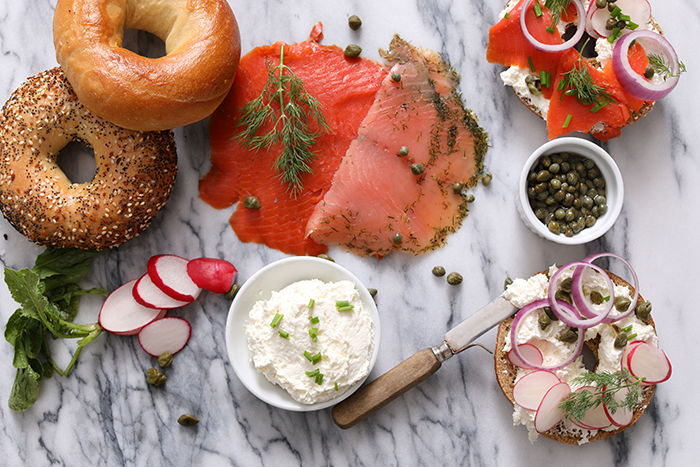
What's your go-to bagel order?
If the capacity to cause controversy is a signifier of success, then bagels are truly a triumph. Of course, that's something we Jews have known all along.
Jewish food is as diverse as the Jewish community itself, reflecting cultural, historical, and geographical influences. In North America, though, no single Jewish food is as ubiquitous or well-known as the humble bagel, an favorite that originated in Poland in the 17th century.
When Eastern European Jewish immigrants arrived in North America in the late 1800s and early 1900s, they brought bagels along with them. Soon, the boiled-and-baked bread found favor within the Jewish community and beyond. Crunchy and golden-brown on the outside but soft and chewy within, bagels quickly won over the public.
As bagel shops became neighborhood fixtures, these doughy, ring-shaped treats began to transcend their Ashkenazi origins to contribute to a broader culinary experience and have been a cultural icon ever since.
This surge in popularity brought about a wide range of variety, often divided by geographic region. The dense, chewy bagels of New York City get their signature taste, texture, and crust from being boiled in barley-malt water, while bagels on the west coast of the United States are softer and airier in the middle and made using fermentation. In Tucson, AZ, one baker has developed Sonoran-style bagels that are steamed instead of boiled, while Montreal bagels are smaller and sweeter than their U.S. counterparts and baked in wood-fired ovens. And that doesn't even begin to cover all the different flavors of bagels or the many combinations of toppings and fillings they can be paired with.
In 2022, data from GrubHub showed that the most popular bagels ordered through its site were blueberry, cinnamon raisin, everything, asiago, and rainbow. On its list of popular bagel sandwich orders, bacon-egg-and-cheese earned the top spot, while the classic Ashkenazi lox came in at number five.
As it turns out, the general public has lots of opinions about bagels - not just about those particular statistics, but about bagels in general. Across the internet, debates abound: To toast or not to toast? Is it OK to scoop out the middle? Is a bagel without a hole really a bagel at all?
There are even questions about the right way to slice them: Horizontally or vertically? If horizontally, which half is better? And is there a wrong way to cut a bagel? Most people seem to agree on the answer to the latter, as evidenced by the outcry on social media any time a photo goes viral of a bagel sliced into thin pieces like a steak.
Despite having made their way into mainstream food culture, bagels remain a critical symbol of Ashkenazi culinary culture - and a staple at Jewish gatherings. At , , brunches, and break-fasts, platters overflow with bagels and tasty accoutrements like lox, cream cheese, capers and onions. They're also a favorite of many Jewish home cooks, who whip up old-fashioned bagels for Shabbat, DIY no-boil bagels for snacks, and even matzah meal bagels for . In short, there are just as many ways to enjoy bagels as there are bagel flavors, orders, and shops themselves (there are more than 500 bagel shops in New York City alone).
While we may not all agree on shmear flavors, toppings, or even the right slicing technique, one thing is clear: bagels have become a visible (and delicious) symbol of Jewish tradition, heritage, and influence in North America - and that's certainly something worth celebrating. Pass the bagels, please!
Related Posts

Superman Can Inspire Us to be Jewish Heroes


